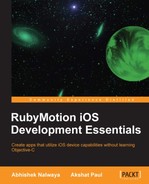Book Description
Forget the complexity of developing iOS applications with Objective-C; with this hands-on guide you’ll soon be embracing the logic and versatility of RubyMotion. From installation to development to testing, all the essentials are here.
- Get your iOS apps ready faster with RubyMotion
- Use iOS device capabilities such as GPS, camera, multitouch, and many more in your apps
- Learn how to test your apps and launch them on the AppStore
- Use Xcode with RubyMotion and extend your RubyMotion apps with Gems
- Full of practical examples
In Detail
RubyMotion is a revolutionary toolchain for iOS app development. With RubyMotion, you can quickly develop and test native iOS apps for the iPhone and iPad, combining the expressiveness and simplicity of Ruby with the power of the iOS SDK.
"RubyMotion iOS Development Essentials" is a hands-on guide for developing iOS apps using RubyMotion. With RubyMotion, you can eliminate the complexity and confusion associated with the development of iOS applications using Objective-C.
We’ll begin from scratch. Starting by installing RubyMotion, we’ll build ourselves up to developing an app that uses the various device capabilities iOS has to offer. What’s more, we’ll even learn how to launch your app on the App Store!
We’ll also learn to use iOS SDK classes to create application views. Discover how to use the camera, geolocation, gestures, and other device capabilities to create engaging, interactive apps. We’ll develop stunning user interfaces faster with the XCode interface builder and make web apps by using WebView. We’ll then augment applications with RubyMotion gems, doing more by writing less code and learn how to write test cases for RubyMotion projects. Finally, we’ll understand the app submission process to push your app to Apple’s App Store
With "RubyMotion iOS Development Essentials", we will learn how to create iOS apps with ease. At the end of each chapter we will have a tangible and running app, which utilizes the concepts we have learnt in that chapter.
Table of Contents
- RubyMotion iOS Development Essentials
- Table of Contents
- RubyMotion iOS Development Essentials
- Credits
- About the Authors
- Acknowledgement
- About the Reviewers
- www.PacktPub.com
- Preface
- 1. Getting Ready for RubyMotion
- 2. Instant Gratification – Your First Application
- 3. Evolution – From Objective-C to RubyMotion
- 4. Mastering MVC Paradigm
- 5. User Interface – Cosmetics for Your App
- 6. Device Capability – Power Unleashed
- 7. Interface Builder and WebView – More Goodies!
- 8. Testing – Let's Fail Gracefully
- 9. Creating a Game
- 10. Getting Ready for the App Store
- 11. Extending RubyMotion
- Index
